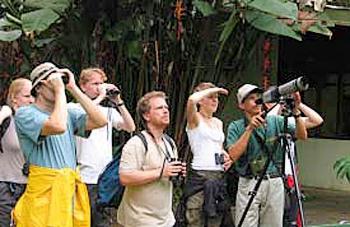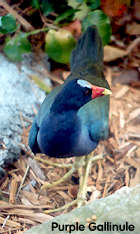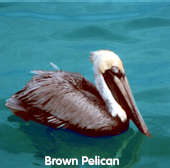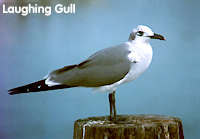
|
 Birding


Birders in Belize have the opportunity to observe hundreds of different species of
birds, and it is not uncommon to view 50 in a single outing. Belize has recorded
over 500 species of birds within its borders and many of the migratory birds that
flock to Belize are accounted for during the annual Audubon Christmas Bird Count. |
Audubon 106th Annual
Christmas Bird Count to
take Place December 14th,
2005 - January 5th, 2006
Press Release - National Audubon Society
– October 31st, 2005 – From December
14th, 2005 to January 5th, 2006,
the National Audubon Society’s longestrunning
wintertime tradition, the annual
Christmas Bird Count (CBC), will take
place throughout the Americas. During
the 106th CBC, approximately 55,000
volunteers of all skill levels are expected
to take part in this census of birds.
“Having fun while birding can identify important results that help shape the
direction of bird conservation,” says
Geoff LeBaron, National Audubon
Society’s Christmas Bird Count director.
“Audubon and our partners at the
Patuxent Wildlife Research Center and
the Boreal Species Initiative are analyzing
data from the overall CBC database,
and using the results they find to
develop Audubon’s ‘State of the Birds’
report. These important results will be
reflected in 2006 in our ‘State of the
Birds’ waterbirds report, and inform the
Audubon WatchList, which is used to
prioritize Audubon’s bird conservation
activities.”
The CBC began over a century ago
when 27 conservationists in 25 localities,
led by scientist and writer Frank
Chapman, changed the course of ornithological
history. On Christmas Day
in 1900, the small group posed an alternative
to the “side hunt,” a Christmas
day activity in which teams competed
to see who could shoot the most birds
and small mammals. Instead, Chapman
proposed to identify, count, and record
all the birds they saw, founding what is
now considered to be the world’s most
significant citizen-based conservation
effort – and what has become a more
than century-old institution.
Today, in Audubon’s centennial year
(making the CBC five years older than
Audubon!), participants from all 50
states, every Canadian province, parts
of Central and South America, Bermuda,
the West Indies, and Pacific Islands,
will count and record every individual
bird and bird species seen in a
specified area.

Audubon is celebrating its centennial year of protecting birds and other wildlife
and the habitat that supports them. Birds such as the pigeon pictured above
add to the great diversity of our wildlife, and must be protected. |
During the 105th season, about 70 million
birds were counted. Thanks in part
to Bird Studies Canada, a leading notfor-
profit conservation organization that
is the Canadian partner for the CBC,
last year saw a record high yet again:
2,022 individual counts. Each count
group completes a census of the birds
found during one 24-hour period between
December 14 and January 5 in a
designated circle 15 miles in diameter
– about 177 square miles.
The 106th CBC is larger than ever, expanding
its geographical range and accumulating
information about the winter
distributions of various birds. The CBC
is vital in monitoring the status of resident
and migratory birds across the Western
Hemisphere, and the data, which is
100% volunteer generated, have become
a crucial part of the U.S. Government’s
natural history monitoring database. Articles
published in the 104th and 105th CBC
issues of American Birds define new
methods of analyses of large citizen-science
data sets, with relevance to other
programs beyond the CBC.
Count results from 1900 to the present
are available through Audubon’s website
www.audubon.org/bird/cbc. Included in
those results is the last report of the Ivorybilled
Woodpecker in the CBC database
– two birds that were seen in the Singer
Tract in Louisiana during the 38th CBC in
1937. Other sightings were reported earlier
in the 1930s.
“Over five human generations, the
CBC has evolved into a powerful and
important tool, one probably inconceivable
to any of the 27 participants on
the first Christmas Bird Count,” said
LeBaron. “With continually growing
environmental pressures, the value of
the current data might even exceed the
imagination of today’s participants.”
CBC compilers enter their count
data via Audubon’s website at
www.audubon.org/bird/cbc or
through Bird Studies Canada’s
homepage at www.bsc-eoc.org,
where the 106th Count results will be
viewable in near real-time. Explore
this information for the winter of 2005-
2006 or visit a count from the past.
See if and how the state of your local
birds has changed during the last
25...50...or 100 years.
Audubon is celebrating its centennial
year of protecting birds and other
wildlife and the habitat that supports
them. Our national network of community-
based nature centers and
chapters, scientific and educational
programs, and advocacy on behalf of
areas sustaining important bird populations,
engage millions of people of
all ages and backgrounds in positive
conservation experiences.

Click here and here for more on the Birds of Belize
Here is a list of the birds spotted recently on a birding expedition:




|
Pied-billed Grebe
Anhinga
Brown Pelican
Magnificent Frigatebird
Double-crested Cormorant
Olivaceous Cormorant
Royal Tern
Gull-billed tern
Forster Turn
Least Tern
Sandwich Tern
Laughing Gull
Ring-billed Gull
Herring Gull
American Golden Plover
Wilson's Plover
Semipalmated Plover
Snowy Plover
Black-bellied Plover
Collared Plover
Ruddy Turnstone
Killdeer
Spotted Sandpiper
Bairds
Solitary Sandpiper
Upland Sandpipper
Least Sandpiper
Western Sandpiper
Pectoral Sandpiper
Stilt Sandpiper
Short-billed Dowitcher
Common Snipe
Sora
Little Blue Heron
Great Blue Heron
Great Blue Heron (white phase)
Snowy Egret
Great Egret
Black-crowned Night-Heron
Yellow-crowned Night-Heron
Northern Boat-billed Heron
Cattle Egret
Green Heron
Reddish Egret
American Bittern
Least Bittern
Bare-throated Tiger Heron
Tri-colored Heron
White Ibis
Wood Stork
Black-necked stilt
Willet
Whimbrel
Sanderling
Lesser Yellowlegs
Greater Yellowlegs
Roseate Spoonbill
Clapper Rail
Gray-necked Rail
Purple Gallinule
Sungrebe
Sandhill Crane
American Coot
Swainson's Thrush
Louisana Water Thrush
Northern Water Thrush
Wood Thrush
Ringed Kingfisher
Belted Kingfisher
Green Kingfisher
Osprey
Common Black Hawk
Great Black Hawk
Roadside Hawk
Gray Hawk
White-tailed Hawk
Black-shouldered Hawk
American Kestrel
Merlin
Turkey Vulture
Black Vulture
Laughing Falcon
Peregrine Falcon
White-tailed Kite
Black-and-White Hawk-Eagle
Chachalaca
Common Night Hawk
Lesser Night Hawk
Common Pauraque
Potoo
Blue-Winged Teal
Green-winged Teal
Northern Shovler
Blk-Bellied Whistling Duck
White-crowned Pigeon
Pale-vented Pigeon
Caribbean Dove
White-winged Dove
Common Ground Dove
Ruddy Ground Dove
Gray-headed Dove
Gray-fronted Dove
Rock Dove
Aztec Parakeet
Mangrove Swallow
Cliff Swallow
Cave Swallow
Bank Swallow
Barn Swallow
Rough-winged Swallow
Tree Swallow
Gray-breasted Martin
Brown Jay
Yucatan Jay
Tropical Mockingbird
Gray Catbird
Black Catbird
Black Albinated Catbird
Clay-colored Robin
Summer Tanager
Scarlet Tanager
Crimson-collared Tanager
Blue-gray Tanager
|
Black-headed Saltator
Buff-throated Saltator
Gray Saltator
Blue Grosbeak
Rose-breasted Grosbeak
Indigo Bunting
Dickcissel
American Red Start
Bay-breasted
Black-throated Blue Warbler
Black-throated Green
Black and White Warbler
Blue-winged Warbler
Blackburnian Warbler
Common Yellowthroat
Canadian Warbler
Chestnut-sided Warbler
Worm-eating Warbler
Mangrove Warbler
Magnolia
Mourning Warbler
Northern Parula
Palm
Pine
Prairie
Yellow Warbler
Yellowthroated Warbler
Prothonotary Warbler
Tennessee Warbler
Townsend's Warbler
Swainson's Warbler
Yellow-breasted Chat
Bananaquit
Ovenbird
Green-backed Sparrow
Lark Sparrow
Clay-colored Sparrow
Cedar Waxwing
Solitary Vireo
Mangrove Vireo
Yellow-throated Vireo
White-eyed Vireo
Red-eyed Vireo
Yucatan Vireo
Cozumel Vireo
Philadelphia Vireo
Rufous-browed Peppershrike
Veery
Bronzed Cowbird
Great-tailed Grackle
Baltimore Oriole
Hooded Oriole
Orange Oriole
Altamira Oriole
Orchard Oriole
Yellow-backed Oriole
Yellow-billed Cacique
Yellow-headed Blackbird
Oropendola
White-collared Seedeater
Cinnamon-rumped Seedeater
Black Seedeater
Sharpe's Seedeater
Clay-colored Sparrow
Chipping Sparrow
Bobolink
Cinnamon Hummingbird
Rufous-tailed Hummingbird
Little Hermit
Ruby-throated Hummingbird
Green-breasted Mango
Forked-tailed Emerald
Masked Tityra
Great Kiskadee
Social Flycatcher
Sulphur-bellied Flycatcher
Streaked Flycatcher
Forked-tailed Flycatcher
Great-crested Flycatcher
Boat-billed Flycatcher
Scissor-tailed Flycatcher
Olive-sided Flycatcher
Common-tody Flycatcher
Least Flycatcher
Alder Flycatcher
Duskey-capped Flycatcher
Rose-throated Becard
Tropical Pewee
Eastern Wood Pewee
Tropical Kingbird
Eastern Kingbird
Squirrel Cuckoo
Mangrove Cuckoo
Black-billed Cuckoo
Groove-billed Ani
Smooth-billed Ani
Yellow-bellied Elaenia
Caribbean Elaenia
Citreoline Trogon
Black Headed Trogon
Golden-fronted Woodpecker
Lineated Woodpecker
Yucatan Woodpecker/Red-vented
Ladder-backed Woodpecker
Yellow-bellied Sapsucker
|
|
Click here to return to the main page for Caribbean Critters
|









